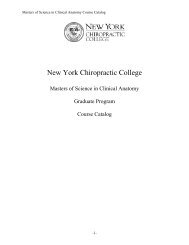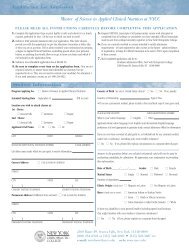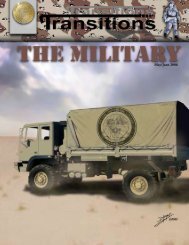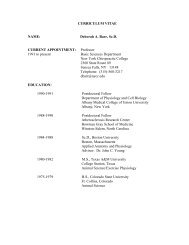July - August 2012 (PDF Version) - New York Chiropractic College
July - August 2012 (PDF Version) - New York Chiropractic College
July - August 2012 (PDF Version) - New York Chiropractic College
You also want an ePaper? Increase the reach of your titles
YUMPU automatically turns print PDFs into web optimized ePapers that Google loves.
Rations – “Fueling” the Military<br />
It’s been said, “An army<br />
marches on its stomach,”<br />
a proverb attributed to<br />
Napoleon and Frederick<br />
the Great, both of<br />
whom were aware that<br />
insufficient calories<br />
and improper nutrition<br />
rendered their troops<br />
less effective in battle.<br />
Throughout history “military rations,”<br />
a term for fixed allowances<br />
of food, were intended to meet the<br />
caloric needs of soldiers under exacting<br />
conditions. Are today’s military rations,<br />
in fact, meeting the nutritional needs of<br />
soldiers?<br />
A Brief History of the Military Ration<br />
The U.S. military is now making an<br />
effort to provide soldiers in the field with<br />
nutritious food that is palatable, portable,<br />
nonperishable, and easily prepared. Food<br />
supplied the troops has evolved over<br />
America’s history.<br />
Garrison rations, first introduced in the<br />
U.S. military in 1775, provided Continental<br />
Army troops with “one pound of beef or<br />
¾ of a pound of pork or one pound of<br />
fish per day, one pound of flour per day,<br />
three pints of peas or beans per week, or<br />
vegetable equivalent, one pint of milk per<br />
day per man, one half pint of rice or one<br />
pint of Indian meal per week per man, and<br />
one quart of spruce beer, or cider.” Good<br />
nutrition, they found, not only helped<br />
soldiers stave off such illnesses as scurvy,<br />
but heightened morale as well.<br />
Portions changed little during the<br />
16<br />
American Civil War, with the exception of<br />
the addition of potatoes. Illnesses such as<br />
typhoid, dysentery, and those easily spread<br />
by contamination of water and food supplies<br />
were rampant. Fatalities were common.<br />
Published by the Army of Virginia in<br />
1861, “Directions for Cooking by Troops<br />
in Camp and Hospitals” (largely written by<br />
Florence Nightingale) emphasized meat,<br />
milk and whole grains, fruit and vegetables.<br />
In the late 19 th century, early nutritional<br />
science hastened changes that stressed<br />
inclusion of a more diverse selection of<br />
vegetables. During the Spanish American<br />
War, vast distances separating supply<br />
chains from American troops left soldiers<br />
eating rotten foods and poor-quality meals.<br />
In fact, the death toll caused by bad food<br />
exceeded combat fatalities!<br />
Better Technology Brings Better Food<br />
Clearly, changes needed to be made.<br />
Studies determined the garrison rations<br />
to be too much food, too high in fat content<br />
and nutritionally unbalanced. During<br />
World War I, the provisions’ balance<br />
improved significantly to comprise 137<br />
grams of protein, 129 grams of fat, and<br />
539 grams of carbohydrates every day,<br />
www.nycc.edu<br />
for a total of roughly 4,000 calories. Still<br />
lacking, however, were fresh vegetables and<br />
essential vitamins. Enter technology: with<br />
advances in food processing and storage it<br />
became possible to supply training camps<br />
with fresh meats, eggs, dairy products,<br />
and vegetables. Troops overseas, however,<br />
could only enjoy vegetables if they could<br />
procure them locally.<br />
Eventually the League of Nations<br />
Commission on Nutrition made recommendations<br />
based on the scientific principles<br />
of nutrition. The recommendations<br />
highlighted the importance of foods such<br />
as green leafy vegetables, fruit, and milk.<br />
Following the war, field studies assessed<br />
the health, performance and nutritional<br />
status of troops in different environments<br />
and led to the development of a variety of<br />
rations for a variety conditions.<br />
K-Rations<br />
During World War II, A-rations (garrison)<br />
were fresh, refrigerated or frozen, and<br />
prepared in dining halls or field kitchens.<br />
B-rations, also known as field rations, were<br />
canned, packaged, or preserved, and could<br />
Continued on next page

















